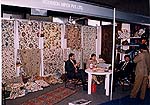|
|
|

|

|
 |
CARPETS
Carpets is not a commodity. It is a piece of art. The Industry in India, dates back to the
Moghul period in the 16th century, when it enjoyed royal patronage. Initially Indian
artisans imbibed the techniques of carpet weaving. Over the years, the craft got
progressively indigenized depicting motifs from Indian paintings.
 Today India is endowed with a wide range of carpet patterns which
include Indian, Chinese, Tibetan, Nepali and Central Asian designs. It provides livelihood
to more than two million artisans belonging to the rural parts of the country. It
contributes to the national economy in several ways and provides employment to the rural,
poor and the economically backward sections of the society. The carpet industry is
essentially in the de-centralized sector and is a traditional craft in which skills are
passed on from one generation to another. Capital investment in this industry is
meagre.
But the returns are immense in terms of foreign exchange. Today India is endowed with a wide range of carpet patterns which
include Indian, Chinese, Tibetan, Nepali and Central Asian designs. It provides livelihood
to more than two million artisans belonging to the rural parts of the country. It
contributes to the national economy in several ways and provides employment to the rural,
poor and the economically backward sections of the society. The carpet industry is
essentially in the de-centralized sector and is a traditional craft in which skills are
passed on from one generation to another. Capital investment in this industry is
meagre.
But the returns are immense in terms of foreign exchange.
India is the only country in the world which can produce the finest of the knots from the
lowest hamadan to the highest Kashmir, Abussons or Berber or Caucasion designs. Indian
carpet weavers are known for commercial flexibility.
India has a 400 year old tradition in carpet weaving, perhaps the only country unlike
Iran, which can produce carpets of any size or according to buyer's demands.
The carpet types available are known by traditional names, which are varied and exotic
because of their origins-Central Asia and Persia.
The list which is long but worth knowing are:-
Names -- Heriz ll, Tabriz,
Djozan, Sarukmir plain, lndo- Tabriz, Superjosagan medallion,
Bidraj, Suladbad, Scharbaff, Ardabil, Mira, moud, Kashmir,
Ghoum, Naini, Kashan, Tree of Life, Hunting Vase Design,
Sohagi, Yaze, Saruk, Joshagan,
Shiraz, kirman, Khorasan.
Sizes -- The sizes normally are: 21/2"x4', 3'x4', 6'x9',
8'x12' and 7'x10'.
Indian carpet weavers, however, can also make sizes according to the buyer's
preference, a
capability which is according to the buyer's rare in the world
Colours -- Fast chrome dyes, chemically washed with water and
natural homemade fast dyes are also used.
Weavings -- The weaving features vary according to the place
where the carpets are made. (The quality of a carpet is judged by the number of knots per
unit area).
Uttar Pradesh -- Sixty counts 5 ply, 10 counts 2 ply 30
counts ply medium quality carpets have 120, 125, 135, 165, 180, 209, 220, 256 knots per
square inch.
Punjab -- 10x11, 22 knots per square inch.
Rajasthan --18x18 medium quality with 144 to 225 knots per
square inch. 11x11, 13x13 knots per single and double waft.
Kashmir -- 18x18, 20x20, Wool/Silk. Medium or higher quality
carpets have between 256 to 576 knots per square inch, 400 to 448 knots per square inch
being common.
In addition, there are Tibetian settlements in different parts of the country where
Tibetian carpets of distinct design are made.
Besides, hand knotted carpets, lndia makes a wide range and variety of machine made floor
coverings to suit all functional and aesthetic needs. A new product which is fast becoming
popular is the jute carpets which is available at one-tenth the price of a good woolen or
silk carpet and yet have pleasing texture, colours and designs. Coir, the coconut husk
fibre, is also lending itself as a good material for floor coverings and wall hangings
blended with rubber or PVC.
|
| Back
|
|
|

Pragati Bhavan, Pragati Maidan, New Delhi-110 001,
Tel. : 91-11-3319841, 3371700, Fax : 91-11- 3318135,
3371871
E-mail : itpo@giasdl01.vsnl.net.in
Site designed and maintained by Expopoint.Com
If you have any comments or find problems accessing this web-site,
feel free to contact
Webmaster |
|
|